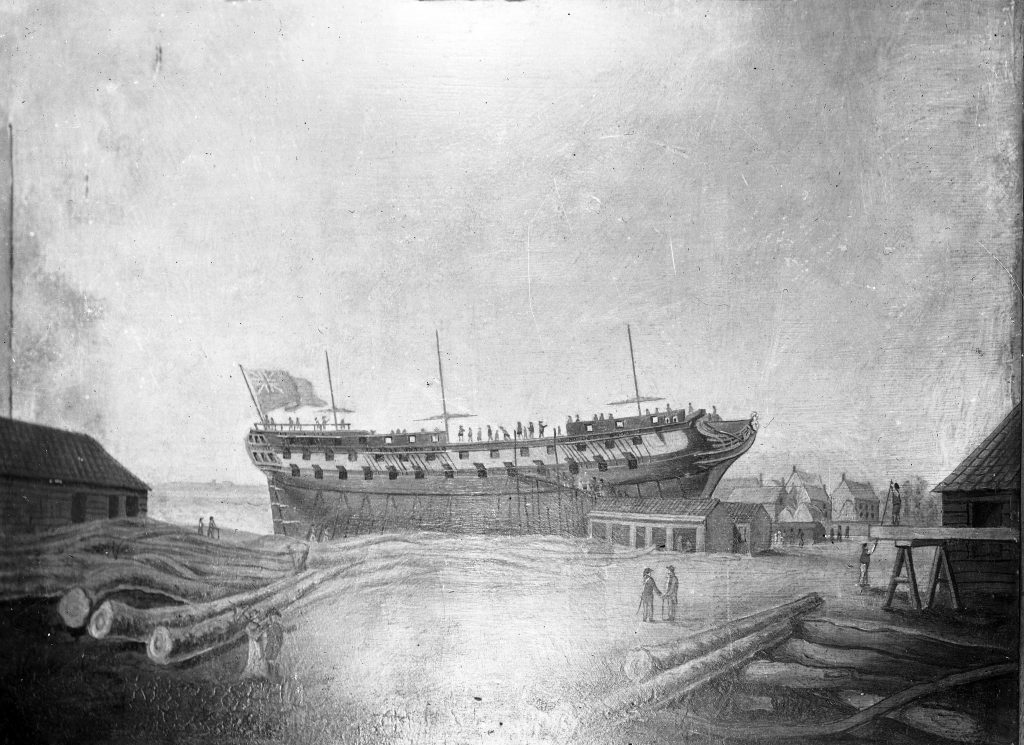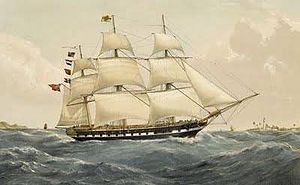Historic Paull
Paull Shipyard
On May 11th 2012 it will be exactly 200 years since the Royal Navy ship of the line HMS Anson was launched from the Shipyard at Paull. The shipyard was further down the river than the present site of Hepworth’s Shipyard, it was at the end of Anson Villas near to the sportsfield. The shipyard was owned by a Thomas Steemson. 1812 was in fact one of their busiest years ever with the completion and launch of the Apollo in January for the East India Company and the preparation to launch HMS Anson in May.

The yard was awash with tradesmen busy with the task of finishing last minute preparations both on HMS Anson and on the construction of the slipway. The previous year the fully rigged ship Gilder was built at Paull and launched on 26th January 1811 for the whaling industry, as was The Brunswick later on the 7th February 1814.
HMS Anson was a 74 Gun Ship of the Line 175 feet in length and of 1,870 tons. She was refitted at Chatham Naval Dockyard for her one and only voyage to Tasmania. She carried 499 male convicts to Hobart , Tasmania. This was the largest number of convicts ever carried by a single ship. The surgeon on the voyage was Andrew Millar MD and he gave an account of the conditions on board which you can read if you click here. One of the convicts on board was a John Button, Convict Number 10783, from Winteringham who was sentenced by Lindsey Quarter Sessions on 7th April 1843 to 10 years transportation to Van Diemen’s Land, Tasmania, aboard the “Anson.”
She left Southampton on 1st October 1843, and landed at Hobart on 4th February 1844, under Captain Coglin. After the convicts were disembarked, she was refitted as a prison, and towed to Prince of Wales Bay, Risdon near Hobart where she was moored, and used as a prison for female convicts from 1844 onwards. This was to alleviate overcrowding at Cascades Female Factory.
At the time of the construction of HMS Anson difficulties arose finding sufficient interested labour owing to people having been tied to various farmsteads through the last Martinmas hirings at Hedon and Driffield, even so, accomodation was difficult to obtain, especially in Paull village itself, but outlying farms offered some basic amenities with the quality and quantity being meagre fare. One enterprising smallholder with a horse and wagon arranged to collect these workers along back roads of South holderness so as to be at Paull Shipyard for a 7 am start. unfortunately he failed to take into account the use of the turnpiked sections of road between Patrington and Hedon, and his profit margin suffered disastrously.
The residents of Elm Terrace in Paull welcomed many new faces to their houses with some people cramming up to four extra boarders in. all being in complete disregard of their landlords terms and conditions. The inns of the village also gained financially, especially at launch times when large crowds of visiting sightseers all came to see the great spectacle. At the time of the launch of HMS Anson a leading Hull newspaper reported the crowd was between 2,000 and 5,000 persons present. The Humber Tavern and The Ship Tavern were extremely busy with shrimp tea refreshments being served and it was reported that ‘realising that supplies would not be sufficient to last until the celebrations were at a close, the village carrier was requested to proceed to Hedon immediately for further casks of ale’. His income was further boosted by genteel people requesting to be taken to Hedon early to retreat from boisterous parties.
Around this time there was serious social unrest in other parts of the country for England was experiencing the worst trade depression since the 1760’s. In 1812 Luddites were burning mills and destroying machinery in the West riding and in Lancashire. In March 1812 at Nottingham Assizes seven of the Luddites were sentenced to transportation for life. War with America was declared on the 12th june 1812 and Napoleon invaded Russia twelve days later. It was probably these times of difficult trading conditions that brought hard times for Mr Steemson and the Paull Shipyard. With the defeat of Napoleon and the threat of French military action reduced, the need for Royal Navy warships declined dramatically. The whaler Brusnwick was probably the last major building project as shortly afterwards in The Examiner dated 2nd May 1819 is reported that Mr Steemson had been declared bankrupt, his solicitors being Messrs Rosser and Son of Bartlett Buildings, Hull.
Parts of the old shipyard were still in use in 1892 where a Mr Richard Dalton carried out his business there as a Wheelwright and Joiner.

Launched 19th November 1808 at Paull
36 Gun Fifth Apollo Class Frigate